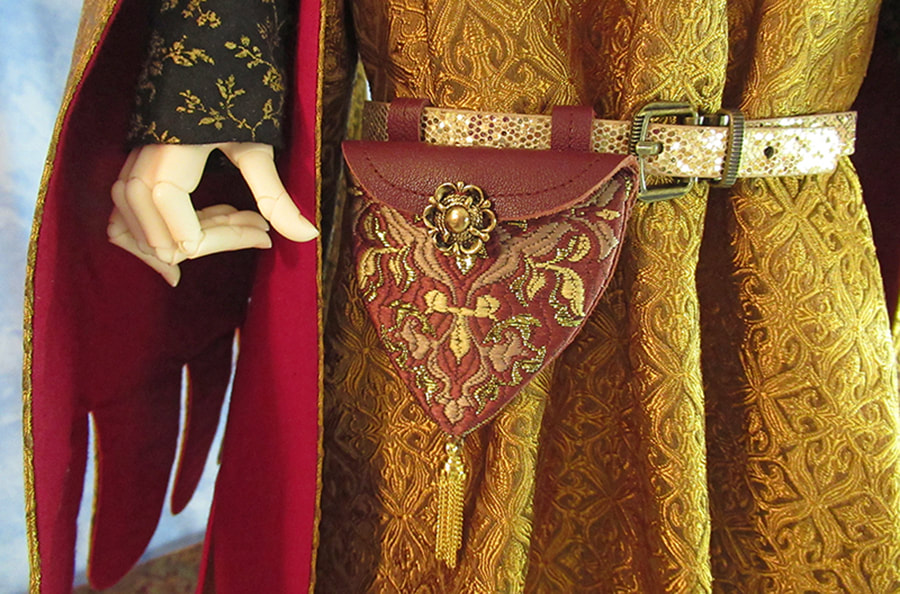JEWELS OF THE RENAISSANCE
I’ve been involved in the Society for Creative Anachronism for almost 40 years, so of course I had to make Elizabethan and Tudor costumes. The real steel 15th century Milanese armor was commissioned from the amazingly talented Slava Kostyurenko of Behelit Workshop in Russia who also constructs full size armor and swords. The knight attends his lady who is garbed in a late 1500's brocade gown with a split front skirt revealing a decorated underskirt, a bodice with shoulder rolls and decorated silk sleeves. Her cuff edges and standing ruff are lace, a 1500's innovation. Her headpiece is an English version of the French hood. A tiny carcanet (necklace) and a profusion of pearls decorate her ensemble.
The early 1500's Tudor king wears a brocade doublet with paned sleeves and figured velvet pants. Fancy blackwork cuffs, a jeweled chain of office and a jeweled golden crown reflect his noble status. His meal consists of a meat pie, dates stuffed with almonds, cheese, bread and fruit. The Tudor lady wears a bodice with elaborate sleeves—velvet on top with enormous flat false sleeves beneath. The blackwork cuffs of her smock show at the wrists. Her skirt is arranged over a farthingale and is split to display the forefront of the underskirt. Her gable hood features a jeweled billiment, brocade lappets and velvet veils in back. Her lapdog begs for attention at her feet. The scholar wears a Tudor style doublet and pants and a velvet robe with a fur collar. The wool hat worn by academics during this period later morphed into the modern mortar board. He carries a book of hours. The throne and table were made by an Etsy artist from the Ukraine.
With the exception of the armor, these costumes were made right after the 2015 show, but had not been displayed anywhere except in my doll room. The original descriptive page is a sub page of this one.
The early 1500's Tudor king wears a brocade doublet with paned sleeves and figured velvet pants. Fancy blackwork cuffs, a jeweled chain of office and a jeweled golden crown reflect his noble status. His meal consists of a meat pie, dates stuffed with almonds, cheese, bread and fruit. The Tudor lady wears a bodice with elaborate sleeves—velvet on top with enormous flat false sleeves beneath. The blackwork cuffs of her smock show at the wrists. Her skirt is arranged over a farthingale and is split to display the forefront of the underskirt. Her gable hood features a jeweled billiment, brocade lappets and velvet veils in back. Her lapdog begs for attention at her feet. The scholar wears a Tudor style doublet and pants and a velvet robe with a fur collar. The wool hat worn by academics during this period later morphed into the modern mortar board. He carries a book of hours. The throne and table were made by an Etsy artist from the Ukraine.
With the exception of the armor, these costumes were made right after the 2015 show, but had not been displayed anywhere except in my doll room. The original descriptive page is a sub page of this one.
JEWELS OF FRANCE AND ENGLAND

I was inspired by the Versailles TV series to make these costumes from the court of Louis XIV. Richly adorned in gold lace, Louis wears a knee length damask coat over a waistcoat, breeches and a blouse with full sleeves and a cravat. Note the red heels on his shoes which Louis introduced to his court in the late 1600's. The lady wears an off-shoulder round neck damask gown with a decorated bodice and open front skirt. They enjoy wine in a salon filled with works of art, including still lifes of flowers and busts on ornate pedestals displaying sculpted helmets in silver, gold and copper.
The lady and man in the aviary wear damask houppelandes from England in the 1400's. Hers a long version with huge sleeves and a double collar, his a shorter style with split dagged sleeves over a high collared shirt. Her headpiece is a reticulated hennin or escoffion, and his is a roundel with a cockscomb and liripipe. The man also wears a folly collar with bells and pointy toed shoes.
The rich damask fabrics of their garments came from the Czech Republic. The little bird cages are tea light holders.
The lady and man in the aviary wear damask houppelandes from England in the 1400's. Hers a long version with huge sleeves and a double collar, his a shorter style with split dagged sleeves over a high collared shirt. Her headpiece is a reticulated hennin or escoffion, and his is a roundel with a cockscomb and liripipe. The man also wears a folly collar with bells and pointy toed shoes.
The rich damask fabrics of their garments came from the Czech Republic. The little bird cages are tea light holders.












































